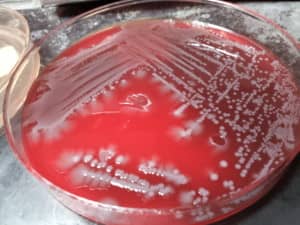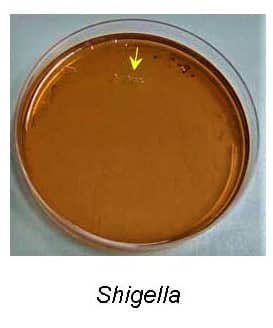MORPHOLOGY OF SHIGELLA DYSENTERIAE (Sh. dysenteriae)
Shape – Shigella dysenteriae is a short, rod shape (bacillus) bacterium.
Size – The size of Shigella dysenteriae is about 1–3 µm × 0.5 µm (micrometer).
Arrangement Of Cells – Shigella dysenteriae is arranged singly or in pairs.
Motility – Shigella dysenteriae is a non-motile bacterium. Some strains of E. coli are non-motile.
Flagella – Shigella dysenteriae is a non-flagellated bacterium.
Spores – The Shigella dysenteriae is a non–sporing bacterium.
Capsule – Sh. dysenteriae is a Non-capsulated bacterium.
Gram Staining Reaction – Shigella dysenteriae is a Gram -ve (Negative) bacterium.

CULTURE REQUIREMENTS OF SHIGELLA DYSENTERIAE (Sh. dysenteriae)
⇒ Special requirements – Shigella dysenteriae have no complex nutritional requirements and readily grow in ordinary media like Nutrient Agar medium (NAM). Commonly the MacConkey Agar medium & XLD medium is used for the cultivation of Shigella dysenteriae in the Laboratory.
⇒ Optimum temperature – Shigella dysenteriae ranges from 10–40°C but the optimum temperature for most of the strains is 37°C and usually cultivated at this temperature in laboratories.
⇒ Optimum pH – Sh. dysenteriae cannot survive at acidic pH below 4.5, the maximum growth observed at 7.0 i.e. neutral pH. Also, the pH requirement varies as per the strain of Escherichia col.
⇒ Oxygen requirements – Shigella dysenteriae (Sh. dysenteriae) is an aerobic bacterium i.e. grow best in the presence of oxygen and it is also a Facultative anaerobic organism i.e. can grow in a low oxygen environment.
⇒ There are various culture media used for the cultivation of Shigella dysenteriae (Sh. dysenteriae) in the laboratory and most commonly the MacConkey Agar medium, XLD medium and Selenite F broth medium is used which may vary as per the SOPs of the laboratory, the other media are as follows –
- Columbia Horse Blood Agar medium.
- Sheep Blood Agar medium.
- Eosin Methylene blue Agar (EMB) medium
- Deoxycholate Citrate Agar (DCA) medium (Selective medium for Salmonella & Shigella).
- Salmonella – Shigella Agar medium (Selective medium for Salmonella & Shigella).
- Xylose Lysine Deoxycholate (XLD) medium (Selective medium for Salmonella & Shigella).
- Selenite F Broth (Selective medium for Salmonella & Shigella).
- The Liquid medium (Trypticase Soy Broth, Nutrient broth, etc.)
Check out the Morphology & Culture Characteristics of Salmonella typhi
MORPHOLOGY AND CULTURE CHARACTERISTICS OF SALMONELLA TYPHI (S. TYPHI)
⇒ The Deoxycholate Citrate Agar (DCA) medium is the Selective medium for Shigella dysenteriae & other Shigella Species as well as Salmonella Spp. contains Deoxycholate and Citrate salts in a concentration that inhibits the growth of many gram-positive bacteria & most of the intestinal flora and supports the growth of Shigella dysenteriae.
⇒ Similarly, the Salmonella – Shigella Agar medium is also a selective medium for Shigella dysenteriae & other species of Shigella as well as Salmonella spp. contains 4 key components that make it selective for Salmonella & Shigella i.e. Bile salts, Brilliant green dye, Sodium citrate & Sodium thiosulfate which selectively inhibit the growth of many gram-positive bacteria & coliform bacteria and supports the growth of Salmonella & Shigella sp.
CULTURE CHARACTERISTICS OF SHIGELLA DYSENTERIAE (Sh. dysenteriae)
Cultural Characteristics Nutrient Agar Medium (NAM) MacConkey Agar medium Blood Agar Medium Xylose Lysine Deoxycholate Agar (XLD) Medium
Shape Circular Circular Circular Circular
Size 1-2 mm 1-2 mm 1-3 mm 2-3 mm
Elevation Convex Convex Convex Convex
Surface Smooth Smooth Smooth Smooth
Color Greyish white Colorless Greyish white Red without black center
Structure Translucent Transparent Translucent Translucent –Opaque
Hemolysis ----- ----- γ-Hemolysis (Non - Hemolytic) -----
Check out the preparation of MacConkey Agar medium in Laboratory
In liquid culture media like Trypticase soy broth or Nutrient broth, the growth of the bacterium occurs as turbidity in the broth medium but the chances of contamination are high especially when the isolation is carried out from Feces specimen, commonly the Selenite F broth and Tetrathionate broth is used for the isolation of Shigella dysenteriae.
In Blood Agar medium, the Shigella dysenteriae shows gamma hemolysis i.e. no hemolysis occurs on blood agar medium, the colonies are grayish-white and grows well.

In MacConkey Agar medium, the colonies of Shigella dysenteriae are colorless due to the lack of lactose fermentation which is of great importance in differentiating Sh. dysenteriae from other Bacteria present in the specimen, especially from Gram-positive bacteria and Escherichia coli which is lactose fermentor and gives Pink color colonies on MacConkey agar medium.
In Eosin Methylene Blue Agar (EMB) medium, the colonies of Shigella dysenteriae are colorless due to lack of lactose fermentation.
In the Deoxycholate Citrate Agar medium, the colonies of Shigella dysenteriae are colorless due to Non-Lactose Fermentation (NLF).
In Salmonella Shigella Agar medium, the colonies of Shigella dysenteriae are Colorless. Hydrogen sulfide is not produced by Shigella dysenteriae.

Selenite F broth, the enrichment medium for Shigella & Salmonella species, commonly used for the isolation of the organism from the fecal sample where the density of Shigella dysenteriae may be too low in early stages of infection. The fecal specimen inoculated in Selenite F broth are incubated for 6-12 hours generally (not more than 24 hours) and then subcultured on XLD medium or any other selective medium.

That’s all about the Morphology and Culture Characteristics of Shigella dysenteriae
Further Reading:

Hi, I’m the Founder and Developer of Paramedics World, a blog truly devoted to Paramedics. I am a Medical Lab Tech, a Web Developer and Bibliophiliac. My greatest hobby is to teach and motivate other peoples to do whatever they wanna do in life.
Super images tq for making me understand
I love what I saw,it describes my practical work